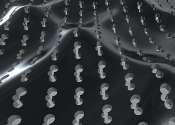Yes, some animals can have babies without a mate. Here's how
A boa constrictor in the U.K. gave birth to 14 babies—without a mate.

A boa constrictor in the U.K. gave birth to 14 babies—without a mate.
Plants & Animals
Jul 3, 2024
0
0

The advent of quantum computers promises to revolutionize computing by solving complex problems exponentially more rapidly than classical computers. However, today's quantum computers face challenges such as maintaining stability ...
Nanophysics
Jul 3, 2024
0
126

Domesticated animals play a prominent role in our society, with two-thirds of American families enjoying the companionship of pets and many others relying on animal products for their nutritional needs. But the process of ...
Plants & Animals
Jul 1, 2024
0
185

Once upon a time, seagrass meadows of about 150 square kilometers covered the bottom of the Dutch Wadden Sea. Now, seagrasses have all but disappeared, just like in many other places in the world. But these unique saltwater ...
Ecology
Jun 27, 2024
0
0

Marine plastic pollution is a massive environmental issue, with a plastic smog of an estimated 170 trillion particles afloat in the world's oceans. This highlights how urgently we need to develop strategies to mitigate this ...
Environment
Jun 24, 2024
0
40

A demonstration of how new technologies can be used in 21st century crop breeding comes from just published research that combines laser scanning and 3D printing to create a detailed 3D model of a sugar beet plant.
Biotechnology
Jun 19, 2024
0
154

Parrots, songbirds, and hummingbirds can learn to make new sounds. No-one knew, but New Zealand's smallest bird, the rifleman or titipounamu, may have a rudimentary version of the same talent.
Plants & Animals
Jun 14, 2024
0
48

SMU nanotechnology expert MinJun Kim and his team have developed a faster, more precise way to detect the properties and interactions of individual proteins crucial in rapid, accurate, and real-time monitoring of virus-cell ...
Bio & Medicine
Jun 13, 2024
0
26

In the movie "Jurassic Park," scientists extracted DNA that had been preserved in amber for millions of years, and used it to create a population of long-extinct dinosaurs.
Biochemistry
Jun 13, 2024
0
108

DNA is the molecule that contains all the genetic information necessary for the development and functioning of living organisms. It is organized in a structure called "chromatin," which is found inside the nucleus of cells. ...
Molecular & Computational biology
Jun 13, 2024
0
27
A DNA sequence or genetic sequence is a succession of letters representing the primary structure of a real or hypothetical DNA molecule or strand, with the capacity to carry information as described by the central dogma of molecular biology.
The possible letters are A, C, G, and T, representing the four nucleotide bases of a DNA strand — adenine, cytosine, guanine, thymine — covalently linked to a phosphodiester backbone. In the typical case, the sequences are printed abutting one another without gaps, as in the sequence AAAGTCTGAC, read left to right in the 5' to 3' direction. Short sequences of nucleotides are referred to as oligonucleotides and are used in a range of laboratory applications in molecular biology. With regard to biological function, a DNA sequence may be considered sense or antisense, and either coding or noncoding. DNA sequences can also contain "junk DNA."
Sequences can be derived from the biological raw material through a process called DNA sequencing.
In some special cases, letters besides A, T, C, and G are present in a sequence. These letters represent ambiguity. Of all the molecules sampled, there is more than one kind of nucleotide at that position. The rules of the International Union of Pure and Applied Chemistry (IUPAC) are as follows:
This text uses material from Wikipedia, licensed under CC BY-SA